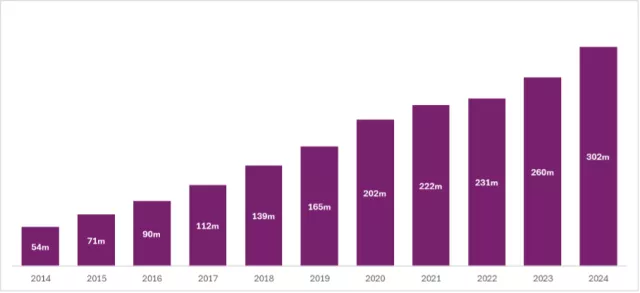The shift in how consumers watch TV
The entertainment landscape and the way people watch TV has undergone a seismic shift over the past decade. Streaming services have surged in popularity, fundamentally changing how audiences access and engage with content.
On average, consumers spend 1 hour and 47 minutes a day watching linear TV versus 1 hour and 22 minutes daily on streaming services. Consumers today navigate between live TV, on-demand content, and streaming services. They still value traditional broadcast TV, but the era of flipping through a TV guide and adhering to fixed schedules, has largely been replaced by on-demand, binge-watching experiences. Netflix subscriptions, for instance, have increased by over 400% since 2014*, with Prime Video, Disney+, and other streaming services seeing a similar trend.
The convenience and flexibility of streaming and on-demand platforms have resulted in a change in customer behaviour and expectations. This shift in viewing habits has put pressure on Pay TV operators to rethink their offerings and to innovate beyond their current offerings to stay relevant.
Today’s viewers demand:
- Flexibility: Access to content at any time, across any device.
- Personalisation: Tailored recommendations and curated experiences.
- Seamlessness: Easy navigation and minimal interruptions from ads.
Comcast/Sky’s research underscores a growing customer preference for features like content aggregation – bringing recommendations from multiple content providers into one unified experience – and ease-of-use functionality like unified voice search. About 30% of existing Pay TV customers are willing to pay a premium for platforms that offer these capabilities. However, many Pay TV providers struggle to meet these demands, often being bound by legacy infrastructure and outdated programming models.
(Source: https://www.gwi.com/blog/streaming-trends-and-stats + Comcast/Sky’s own research).
The need for innovation beyond traditional Pay TV and streaming
As viewing habits shift, operators must rethink their strategies to redefine their role in an increasingly fragmented entertainment ecosystem. Many providers have responded by integrating streaming apps into their set-top boxes to provide access to third-party content while keeping customers connected to their TV environment. Others have gone further and launched their own streaming services to enable access to their content on platforms beyond their own.
While these steps help bridge the gap, they fall short of delivering a truly seamless, unified experience that customers now expect. Viewers don’t want to juggle multiple apps or search across different platforms to find content. They want everything in one place, with intuitive discovery and personalisation built in.
At the same time, declining traditional TV revenues and forecasted decline in subs make large CAPEX investment in modernising legacy platforms more difficult. The challenge isn’t just about adding streaming access, it’s about rethinking the entire user experience to combine the best of Pay TV and streaming into a more flexible, personalised, and easily navigable platform.
Addressing the challenges with Comcast’s Entertainment OS
Comcast has embraced this challenge with Entertainment OS, an operating platform that redefines home entertainment. With Entertainment OS, operators can offer a seamless experience across devices, ensuring customers enjoy a consistent and intuitive interface, whether they’re watching live TV, on-demand content, or streaming services.
While many other platforms also offer content aggregation, it goes far beyond simply pulling content into one place-- it provides a fully integrated ecosystem that allows an operator to maintain control over their offerings, branding, and customer relationships.
Entertainment OS allows operators to create a fully branded experience that reflects their services, unlike other platforms that require a certain level of prominence for their brand and inclusion of their services.
Entertainment OS also ensures that operators retain control over platform data. This means they can offer personalised recommendations, optimise content discovery, and build targeted advertising strategies, all while maintaining subscriber privacy and trust.
Meeting customer needs while boosting operator ROI
Beyond Comcast customers, operators across the globe can leverage Entertainment OS to modernise their offerings, whether deployed through fully integrated smart TVs, streaming-enabled set-top boxes, or existing hardware. Entertainment OS helps operators deliver advanced entertainment experiences, without requiring significant CAPEX investments.
Because TV consumer habits and technology are constantly evolving, Entertainment OS is built to evolve with them. Backed by Comcast’s ongoing R&D and global scale, the platform continuously integrates new innovations, giving operators the tools to stay ahead.
Transforming Challenges into Opportunities
Today’s TV customers now expect a seamless, personalised, and flexible viewing experience and operators should evolve to meet these modern viewing habits. Entertainment OS enables this transformation, giving operators the tools to meet the customers’ expectations in a way that’s simple, seamless, and adds value to subscribers, without the cost and complexity of building and managing such an advanced platform independently in-house.
What’s your strategy for the entertainment challenge?
Contact us today to see how we can help you rethink your entertainment strategy or start with diving deeper into the features of Entertainment OS and why operators worldwide are choosing it here.

